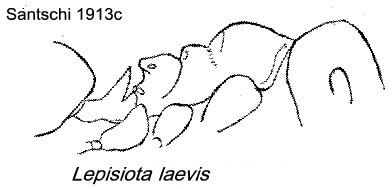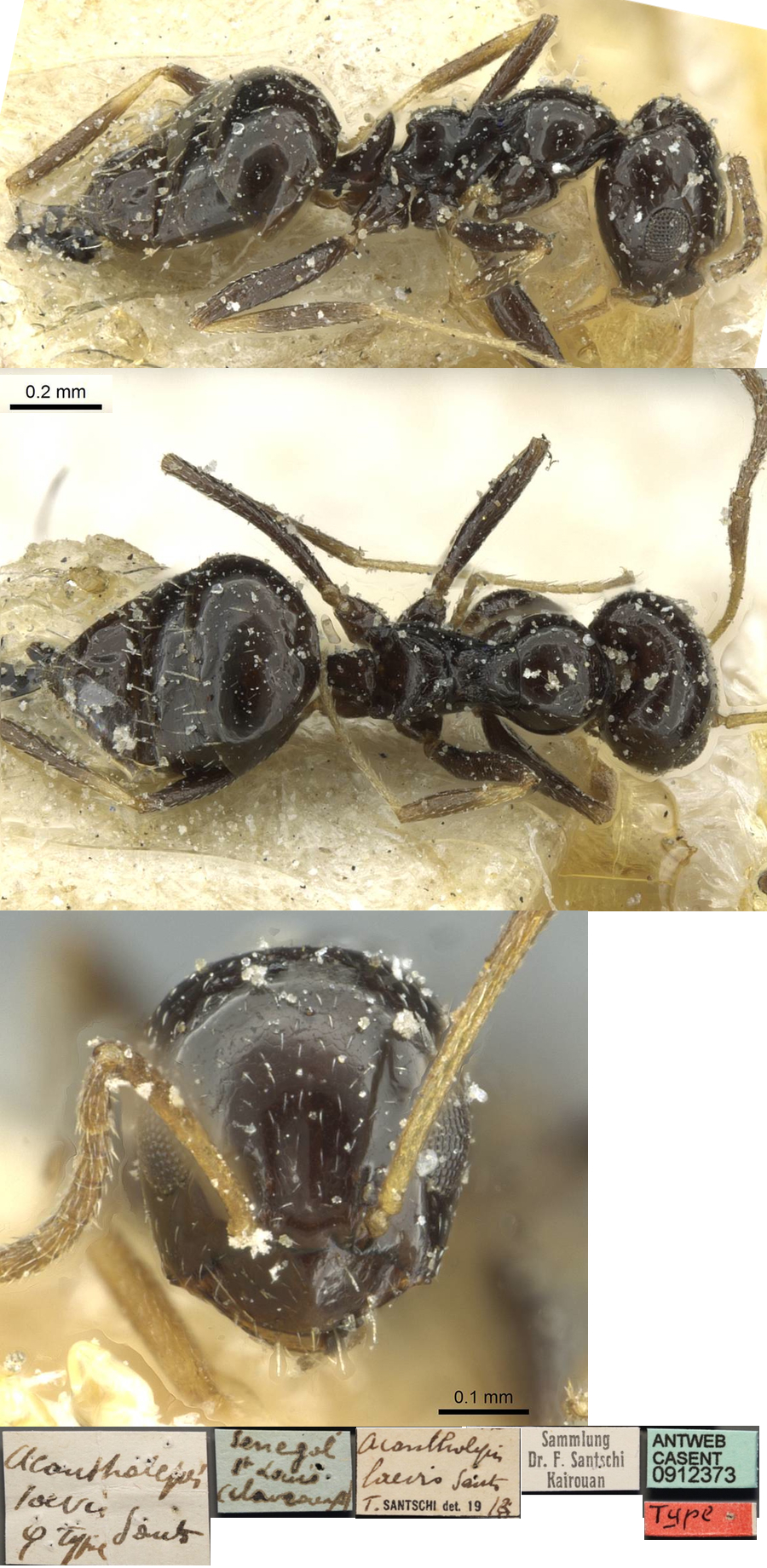Lepisiota laevis (Santschi) - revived status
  Type location Senegal
(Acantholepis laevis n. sp., Santschi, 1913c: 312, illustrated,
worker; stirps of simplex Santschi, 1914d: 378; status as
species, Santschi, 1935a: 278; as ssp of capensis, Bernard
& Cagniant, 1963: 163) collected at St. Louis by Claveau - see below Type location Senegal
(Acantholepis laevis n. sp., Santschi, 1913c: 312, illustrated,
worker; stirps of simplex Santschi, 1914d: 378; status as
species, Santschi, 1935a: 278; as ssp of capensis, Bernard
& Cagniant, 1963: 163) collected at St. Louis by Claveau - see below
variety specularis
(Acantholepis laevior Santschi (= laevis) st. specularis n. st., Santschi, 1935a:
278, worker; ssp "current status", Bolton, 1995: 228) from Zaïre - link below
worker only described  . .
|
 Santschi's
(1913c) description is on Santschi's
(1913c) description is on  Santschi's (1935a) description of specularis
is on Santschi's (1935a) description of specularis
is on 
WORKER - TL 1.7 mm; clypeus with strong carina and
arcuate anterior margin; mandibles smooth; eyes occupy about one-third
of side of head; scapes surpass occiput by about 1/3 of own length;
petiole scale narrowed apically, slightly scalloped and somewhat
inclined; pale or whitish erect pilosity, short thick hairs are
whitish on gaster and around mouth; very shiny; black, basal third
of scapes and tarsi clear yellow brown, rest of antennae and legs brown.
Bernard & Cagniant (1963: 163) gave no authority for
regarding laevis as a subspecies of capensis, but noted
this small (less than canescens) and very shiny form is very
common in the plains of black Africa. The true capensis have short dark erect hairs.
|
 The
photomontage of the type worker is collated
from http://www.antweb.org/specimen.do?name=casent0912373 The
photomontage of the type worker is collated
from http://www.antweb.org/specimen.do?name=casent0912373
The type worker of specularis can be seen at http://www.antweb.org/specimenImages.do?code=casent0912374. Apart from being slightly larger, as shown also by the range of fresh workers below, this appears identical to the laevis type worker.
|
Santschi's
(1935a) description of specularis was - WORKER TL 2 mm; head
rectangular, slightly longer than wide, but as wide apically as
posteriorly; sides convex, occiput and posterior corners slightly
rounded; eyes larger than one-third the sides and set at midpoint of
face; in full face view the eyes just reach the sides of the face;
clypeus convex and faintly carinate, anterior border very arcuate;
postclypeal notch short and feeble; frontal carinae as long as the eye,
more spaced and longer; scapes surpass occipital border by less than
one third their length; funiculus segments 2 and 3 less than quarter
longer than wide; together a little longer than segment 1; alitrunk
short, pronotum slightly wider than long, widest anteriorly; metanotum
shorter than mesonotum, spiracles moderately raised; propodeum dorsum
slightly raised above axis of alitrunk profile; twice as wide
anteriorly as the median width; dorsally convex transversely and
longitudinally; posteriorly slightly concave between the angles, which
spread as short obtuse cones; petiole scale feebly excised and
subdentate; several long hairs on genae and at the apex of the gaster,
other short hairs on the gaster; pubescence very short and very sparse;
smooth and very shiny except mesonotum and propodeum which were
somewhat reticulo-punctate and matt; black, mandibles, distal scape and
tarsi yellow.
Santschi regarded it as a form intermediate to Lepisiota simplex
and Lepisiota
laevis. With simplex the head is bigger and more narrow
anteriorly and rounded behind the eyes; plus a smaller pronotum. With laevis
the antennae are entirely yellow and the scape longer, pronotum as simplex.
With tenuipilis the eyes are set more forward, the gaster
pilosity is more abundant, longer and finer. With Lepisiota minuta
the scape is shorter. It also resembles Lepisiota curta
Emery (type location Somalia) by its pronotum, but that is more
sculptured and the head is narrower.
|
Oxford University Museum
specimens
|
 The
photomontage is of a worker from Senegal, Dakar, collector
David King (King 01-06). The
photomontage is of a worker from Senegal, Dakar, collector
David King (King 01-06).
|
 The
photomontage is of a specimen from Ghana, collected by S Sky
Stephens (06G0020). The
photomontage is of a specimen from Ghana, collected by S Sky
Stephens (06G0020).
|
 The
photomontage is of a worker from Sudan, Kordofan, El Ain, near
El Obeid; collector J Mathews JM 092). The
photomontage is of a worker from Sudan, Kordofan, El Ain, near
El Obeid; collector J Mathews JM 092).
|
 The photomontage is
of specimens from Congo,
Dzio-Dzio, Ngabe, ; collector Yves Braet. The photomontage is
of specimens from Congo,
Dzio-Dzio, Ngabe, ; collector Yves Braet.
|
|